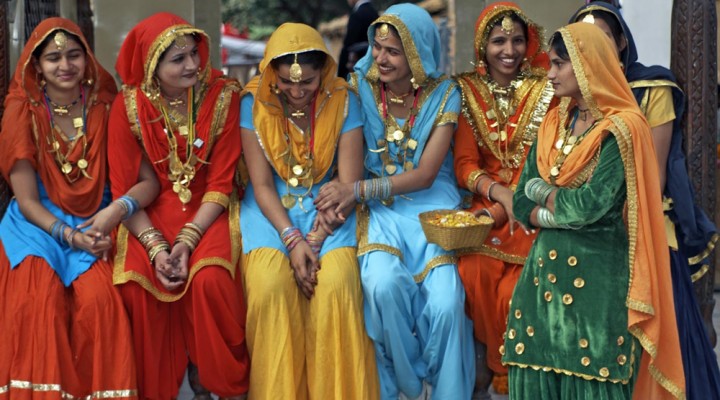India: A Culture of CITIES
India, the second most populous country in the world and the seventh largest country by area, is home to ancient religions, philosophies and cultures. This vast region is now one of the world’s fastest growing major economies. The country itself is a perplexing mix of modern and ancient due its colonial heritage. During much of the 18th century, India was ruled under the British East India Company and then taken over by the United Kingdom in the mid 19th century; finally receiving its independence in 1947 due to the efforts of Mahatma Gandhi and his non-violent resistance movement.
India is home to dozens of languages and yet has no national language. Hindi is used as the official language of government, while English is primarily used in business and administration. This multilingual, multi-ethnic, and enormously eclectic nation is often noted as the spiritual birthplace of some of the world’s most popular religions, including Hinduism, Buddhism, Jainism and Sikhism. It is also known for its biological and geographical diversity, home to the endangered Bengal tiger and the Himalayas, the tallest mountain range on the planet.
India: A Culture of its People
Traveling from the cities to the countryside one notices the sheer breadth of the country itself and its striking contrasts in both landscapes and cultures. The cities are generally characterized by heavy traffic, pollution and a frantic pace of life, but as you make your way out to the shores of the south, men and women still dress in traditional garments, make their living from fishing or small businesses, spend time drinking coconut water and participating in ancient rites, lost in prayer or meditation at their local temples.
India is a world in transition; a home to the growing tech boom in information technology, biotechnology and telecommunications, and yet with its feet still firmly planted in the ground of the Vedas and Upanishads. The Indian people themselves remain fundamentally distinct and yet they remain a cohesive society in many respects with 80 percent of the population regarded as Hindu.
The Hindu religion is an amalgam of philosophies and beliefs accrued over the millennia focusing on daily morality exemplified by the Bhagavad-Gita, one of their principle texts. The epic poem focuses on a conversation between the warrior Arjuna and his divine charioteer the Lord Krishna. Like the texts of many eastern religions the Gita focuses on the task of “sacred duty” and detachment from the fruits of action. Although some Indian religions, such as Buddhism and Jainism, focus on renunciation, most Hindus believe in participating in a worldly life and yet remaining aloft and content amongst an almost serene equanimity.
Muslims make up 13 percent of the population and invading Muslim hordes have left their stamp on the Indian subcontinent through sublime works of architecture. Northward, in the city of Agra is displayed one of the world’s most exemplary architectural achievements, the Taj Mahal, which was built between 1631 and 1648 under orders of emperor Shah Jahan. In 1983 it became a UNESCO World Heritage Site and has been called “the jewel of Muslim art in India and one of the universally admired masterpieces of the world’s heritage.”
And while television arrived late to much of India, it has become the most penetrative source of media in the entire country, reaching over 554 million viewers in 2012. Indian cinema, dominated by the Bollywood of Bombay, is the most watched cinema in the entire world, often a mix of dance, music and improvised dialogue. Even recent Hollywood films, such as Slumdog Millionaire, have taken to India, revealing the dark underground of Indian poverty and latest obsession with Indian television shows spawned off those in the United States like “Who Wants to be a Millionaire?”
It’s a world of bright colors and strong fragrances, rich tasting food and breathtaking landscapes. Indian cuisine is noted for its unique herbs and spices, which were once the focus of early trading with European nations. And while many Indians now dress in jeans, t-shirts or Western-style suits many still cling to the traditional past, women donning beautifully colored cotton saris and red headdresses, while men wrap lungis about their waists. The iconic bindi gracing the heads of Indian women not only accentuates their beauty, but is often used to denote marital status, a red bindi signifying married and a colored bindi indicating single.
advertisement

India Historic
Traveling by train, one has the chance to mingle with the local population, sometimes intimately upon boarding a general class from Kerala to Karnataka, which requires a struggle and some determination, but costs cheaper than a roadside dosa. Similarly, bus rides are inexpensive, just a few dozen rupees and travel can, if properly managed, be highly rewarding. If you like to haggle, hit the streets and name your price! Locals will gladly bargain if you can make your case.
Children sometimes seem too mature for their age, often running their own businesses by selling jewelry, cigarettes or trinkets. And to much despair, they can also be seen on street corners hustling some rupees; they cling to your pants and beg for spare change. And while market reforms have brought advancements and economic wealth to this newly industrialized country, not all have benefited and India remains rife with poverty, disease, malnutrition and inequality.
For all its contrasts and diversity India remains uniquely “Indian.” A country still plagued by third-world problems, its economic diversification and growing GDP have taken a nation immersed in ancient tradition and given them hope on a worldwide stage. With improvements in education and investments from first-world countries, India has been able to adapt to current world conditions and yet retain something of its longstanding noble tradition.
written by Timothy J. Fuller


